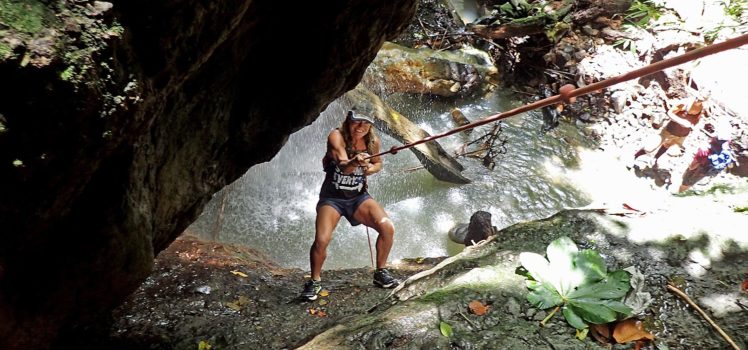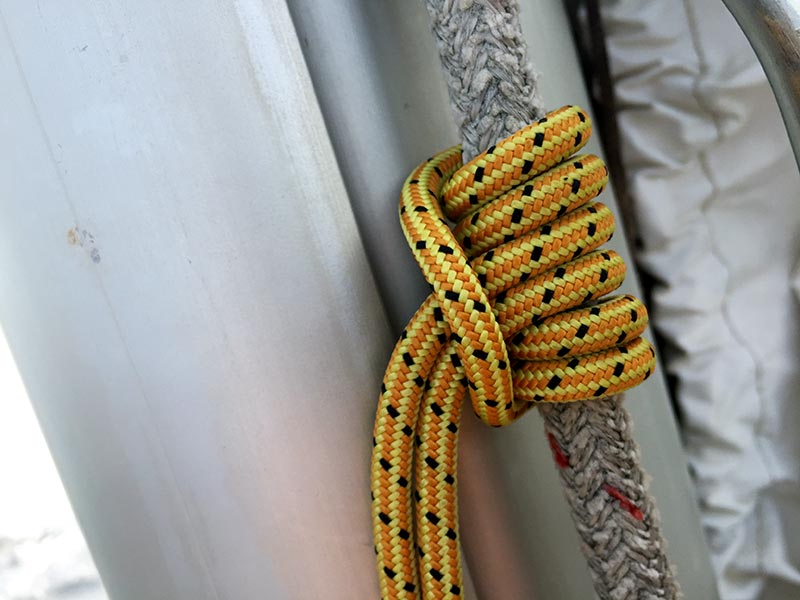Please, my friends, use a backup when going aloft!

No backup being used in this image. Very sketchy, and nerve racking!
Sometimes, when we go hiking, we end up having to ascend or descend some pretty sketchy slopes and cliffs. I almost always get butterflies in my stomach when I’m working my way up and down these areas, putting myself at risk. The truth is though, I feel even worse when I have to watch someone else doing the climbing, even if it’s in a movie. It’s especially bad when the person climbing is someone that I care about!

Rebecca and I went to see this movie last night, Mechanic resurrection.
As you might imagine, I didn’t much care for this scene!
Not surprisingly, I feel a similar bit of anxiety when I see my friends going up the mast on their sailboats, especially if they’re not doing so safely. It astounds me that cruisers, who wouldn’t even consider leaving on a passage without carrying every possible spare part as a backup, routinely go up the mast using less-than-secure technique, and most often without any backup whatsoever! Perhaps it’s the unconscious incompetence thing, they just don’t realize all that they’re missing?
How To Not Die!
Our friend Ken, who I showed working up the mast in yesterday’s pics, has been using a Petzl ASAP as a backup, and I felt very comfortable watching him aloft. I wish that all my friends were being that safety conscious. Assuming that you do recognize the value of being secured to a backup line, but don’t have a cool self-tending device like the ASAP, or another crew member to tend to a backup halyard, you can still acquire a significant margin of safety by using a Prusik knot secured to another fixed halyard.
Here is how the whole thing would work…
- Aquire a 5-6′ length of strong 5-6mm accessory cord.
- Tie it into a loop using a double or triple fisherman’s bend.

- Secure a backup line close to the base of the mast (make it fast), parallel to whatever line you will be ascending on. For example, if you are going up the mast on the main halyard, perhaps you could free the topping lift from the end of the boom and tie it off to the mast base. If you’re going up on the jib halyard, perhaps you could use another headsail halyard as a backup.
- Take your recently-formed loop of cord and tie it to the backup halyard using a Prusik knot.

- Affix the end of that Prusik knot to your harness using a locking carabiner.
- As you are winched up the mast, use one hand to slide the Prusik knot up the backup line. It should move relatively easily up and down the line by sliding it with your hand.
- If the person raising or lowering you has a lapse of concentration, or something catastrophic happens to the line that is holding you aloft, causing you to fall, the Prusik knot will immediately bite on the backup line, preventing you from dropping to the deck.
Before publishing this post, I ran the above text by our rock climbing/sailing friend, Livia. Here is what she had to add:
The obsessive in me adds: rated/trustworthy brand accessory cord, leaving 1-2″ tails on the well snugged fishermans, and attaching locker to a body weight rated attachment point on your harness.
Thanks, Livia!
UPDATE:
We filmed and uploaded a video demonstrating all that I’ve described in this post. You can find the video here.




Great post Mike and thanks for showing me (and everybody else) that Prusik knot.
We have so few friends, I’d hate to lose any of them.
We usually jumar’ed up the main halyard tied off with ascenders and had the other person just back up with another halyard, but that is in large part because our primary winch wasnt huge (our small boom made for a light main, plus only 35′) and so cranking the other person was even harder work than ascenders!
If we had a more powerful winch we would definitely have used this method, much easier than ascenders.
Sincerely, The obsessive
For the non-climbers, a Jumar is a type of ascender. 🙂
https://en.wikipedia.org/wiki/Ascender_(climbing)
Nicepost. Thank you for causing us to pause and think, once again..
Thank you, Sir!
I still jumar using Jumars. Yeah, I’ve been climbing that long! I believe they went out of production in the 80s.
And yeah, use your backups. The farthest I ever watched someone fall was 250 feet. It was bad. The lesson from that fall was that his harness did not fit; he fell out of it, leaving it on the rope, undamaged. The belt must be snug around the narrowest part of the waist such that it cannot be forced down by any means. If you don’t have a waist, don’t climb.
Of course the backup won’t help if you fall out of your harness!
I’d suggest that if you don’t have a waist/hips, you’d better use one of those chest harnesses too. That’s what they have kids wear, right?